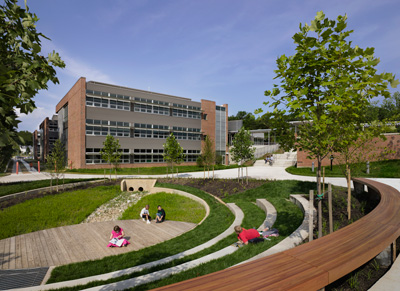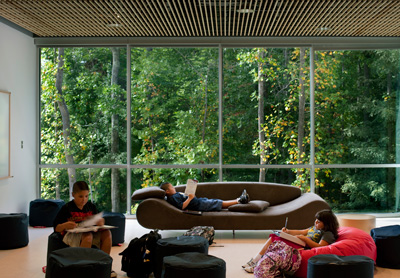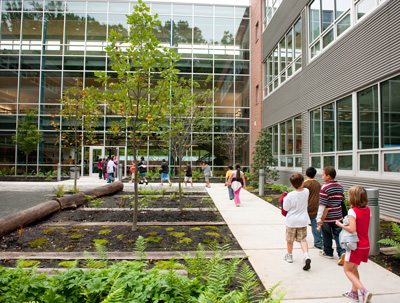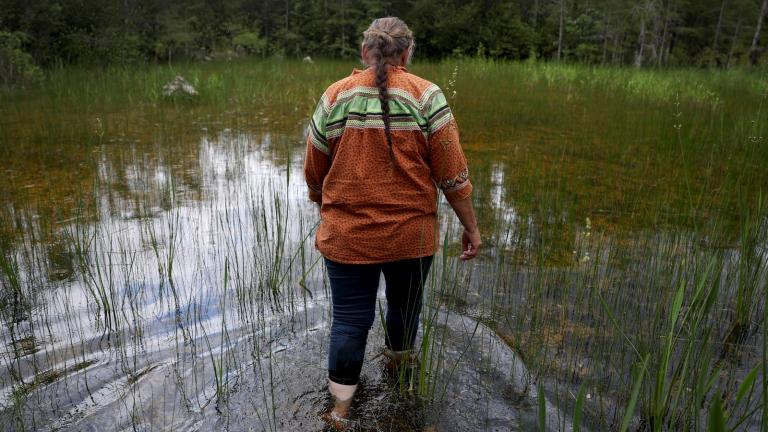
Rachel Gutter, head of the green schools program at USGBC.
Into this dolorous atmosphere came something different: a young woman, bright-eyed and quick-witted, sharing practical tips and stories of tangible achievement — unaware, apparently, that the academics had deemed success impossible. It was like stumbling across a cool drink of water in a desert of navel-gazing wankery. I resolved to find out more about Rachel Gutter and the green schools program she runs.
Gutter joined the U.S. Green Building Council (USGBC) around the time it was developing a LEED rating system for schools in 2007. She expanded those efforts and eventually started a dedicated green schools program inside the organization. It has since taken off, finding unlikely allies in state legislatures, rural school districts, and inner cities — all the places do-gooder greens have failed to reach. I gave Gutter a call to chat about the program’s approach and what’s next for the green schools movement.
—–
Q. What does the green schools program do?
A. A little bit of everything. We do a lot of work on policy at the local, state, and federal levels. For instance, we work with groups of legislators in about 35 states now through the 50 for 50 Green Schools Caucus Initiative. We partner with them, educate them, encourage peer-to-peer sharing of best practices for legislation around green schools.
The Green Schools Fellowship program, based on a successful pilot program in New Orleans, is placing full-time sustainability officers in school districts for three-year terms. You can’t advance system-wide sustainability initiatives unless you’ve made it someone’s job to convene those conversations.
We’ve got a program called USGBC Students where we help students to start groups on their college and university campuses — give them resources, light a fire under them, and they go and transform their campuses, communities, and careers.
Q. How many states have decent green-schools legislation now?
A. There are 12 states plus the District of Columbia that have said they’ll never again build a new school that isn’t green. Greening a school or a district is a complex thing, so a lot of the most important legislation is just beginning to happen, around things like green cleaning and integrated pest management. Lots of these things are low- or no-cost. In Illinois, they passed green-cleaning legislation in 2007.  Manassas Park Elementary School in Manassas Park, Va., is certified LEED Gold and tricked out for green.Photo: Prakash Patel / VMDO ArchitectsSchool districts were concerned the cost was going to be an issue, so there is an exemption built into that law. Since that law was enacted, only six of 4,100-plus schools in Illinois have asked for the exemption.
Manassas Park Elementary School in Manassas Park, Va., is certified LEED Gold and tricked out for green.Photo: Prakash Patel / VMDO ArchitectsSchool districts were concerned the cost was going to be an issue, so there is an exemption built into that law. Since that law was enacted, only six of 4,100-plus schools in Illinois have asked for the exemption.
Q. A lot of K-12 education districts in the U.S. are broke. Is that a source of resistance you have to overcome?
A. Green schools are about saving money and doing better with the money you have. It’s not a conversation about spending money. It’s unfortunate that green has that association sometimes with luxury. We call it eco-balling: spiffed-out solar panels and edible schoolyards and green roofs. All these things are wonderful — I don’t in any way mean to belittle what they can do to inspire education and cultural change in a school district — but for most school districts, those things still come with a price tag they can’t afford.
The real conversation to be had around green schools, the reason there has been such significant uptake in all 50 states, is about stewardship of taxpayer dollars. It’s about finally starting to think about things in terms of ROI [return on investment]. One of the biggest barriers we are trying to help schools overcome is the separation of capital budgets and operating budgets. Schools could save 25 percent off the bat with some basic efficiency measures, occupant education, and engagement programs. I’ve seen it happen.
Best-case scenario are districts like Poudre School District, in Fort Collins, Colo. They’ve found a way to reinvest their [energy] savings into their classrooms, into other sustainability initiatives. In many school districts, it still goes into the black hole of whoever pays the utility bill.
Q. The politics of sustainability have gotten polarized. I imagine there are some school districts where there’s a hair-trigger sentiment against liberal do-gooders. How do you get around that?
A. The first thing is, we don’t just show up there. We identify champions, we identify partners, and whenever possible we aim for peer-to-peer conversation. Sometimes that’s through our chapter networks — we’ve got chapters in all 50 states. Collectively there are more than 1,200 volunteers spread out throughout green schools committees. We’ve encouraged them to reach out beyond the architects, engineers, and facilities managers and bring in teachers, Kids chillin’ in the Manassas Park Elementary School “breakout space.”Photo: Prakash Patel / VMDO Architects school board members, and administrators. Ultimately this stuff is common sense, but if you don’t engage people in a partnership early on, you’re not going to be successful.
Kids chillin’ in the Manassas Park Elementary School “breakout space.”Photo: Prakash Patel / VMDO Architects school board members, and administrators. Ultimately this stuff is common sense, but if you don’t engage people in a partnership early on, you’re not going to be successful.
There’s a broad spectrum of participants. It’s about knowing who you’re talking to. You don’t go in and talk to the plant managers’ association about sustainability. You just don’t. You talk to them about the average green school saving $100,000 a year.
There was a proposal on the floor of the legislature in Kentucky to start up a green schools caucus. One of the cochairs was a gentleman named Jim DeCesare — he’s a member of the Tea Party, pretty well known for being one of the most conservative members of the legislature. The other was Mary Lou Marzian — she’s one of the most liberal. She and Jim proposed this and the House and Senate unanimously passed the resolution to establish a green schools caucus. Kentucky’s also home to what I think is the first net-zero school in the country — in Turkey Foot, Ky!
Q. How big of a piece is food in the green school equation?
A. It’s becoming increasingly bigger. The nutrition, wellness, and obesity campaigns that have been running in parallel to the green schools conversation, they’re starting to converge through things like schoolyard garden projects. It’s exciting to see those two worlds colliding.
 Malia Obama loves her green school.Photo: B Sun (Fl)ow(n)erQ. Any idea if Michelle Obama has gotten on the green school train?
Malia Obama loves her green school.Photo: B Sun (Fl)ow(n)erQ. Any idea if Michelle Obama has gotten on the green school train?
A. Here is where I will shamelessly namedrop. Michelle Obama’s girls go to Sidwell Friends, the first school in the country to achieve LEED Platinum certification. When I was at the White House, my CEO Rick [Fedrizzi] and I mentioned that to her. She said, “I know, that was why Malia chose to go there.”
Q. That’s awesome.
A. There is definitely an awareness. She’s done a good job of staying laser-focused on her campaign, but I do think you’re going to see some new activity and conversations in the federal agencies and the administration in the near future.
Q. Do green schools also mean transportation options for neighborhoods — getting kids to walk, bike, or bus to school rather than driving? How far outside the building does your focus extend?
A. LEED has a significant focus on transportation. With LEED 2009, we added a tremendous amount of weight to alternative transportation: walkable communities that have a denser concentration of services, schools that have safe pathways and bike paths to school, alternative-fuel or high-efficiency buses, incentive programs for carpools for teachers and students, and so forth.
Q. Are there good studies of student performance in green schools?
A. What we’re missing are the roll-up studies of a green super-school: a collection of environmental, education, architectural, and operational best practices. We do have decades’ worth of research that isolates specific aspects of a green school. For example, 17 separate studies have concluded that improvements to the indoor air quality of buildings improve occupant health. We know that mold often is an aggravator to asthma, the No. 1 cause of disease-related absenteeism in public schools. We know that if teachers and students are in class more often, students do better in school. There isn’t nearly as much research going on right now as I hope there will be in a couple of years — that’s part of the center’s agenda, to motivate that.
I’m very careful around making any kind of claim that a green school will improve [academic] student performance; school administrators know it’s very, very hard to isolate factors that lead to an improvement in performance. They’ve been trying to figure that out for a long time. I’m not so doe-eyed I think we’re going to be the exception to that.
Q. Is there a role for creative financing?
A. We’re starting to see some good activity there. Our emphasis with the utilities is around green performance contracting, trying to undertake a more comprehensive sustainability approach. The mayor of Sacramento, Kevin Johnson, has committed to working across a bunch of the neighboring cities in the Sacramento metro area to create a $100 million revolving loan fund for green school retrofits. Higher education has done some amazing things, like Harvard’s green building revolving loan fund — even in the best economic times, it has a higher ROI than their endowment.
Q. Are there good examples of students taking the initiative on greening?
A. We’ve been doing a good job in higher education, but I’m excited to ramp up our efforts to make students the agents of change in a K-12 setting. We’re working on a book called Green My School, a followup to the book written by my co-author Tom Feegel called Green My Parents. It says:  These kids are actually excited to go to school.Photo: Sam Kittner / VMDO ArchitectsYou don’t need anybody’s permission to green your school. You’re a kid. You’re powerful. Go figure out what’s in your way and how you move past it.
These kids are actually excited to go to school.Photo: Sam Kittner / VMDO ArchitectsYou don’t need anybody’s permission to green your school. You’re a kid. You’re powerful. Go figure out what’s in your way and how you move past it.
I met a young woman named Alexa last week, who goes to an all-girls school in L.A. called the Marlborough School. She and her classmates created a curriculum to teach students about sustainability, nature, and stewardship. They pursued a grant for a whopping $2,500, which will allow them to go into 30 schools in the next three years with this curriculum. It’s amazing.
They do a schoolyard safari, take kids out with donated digital cameras and have them take pictures of things around their school that are destructive and things that are beautiful. It’s challenging kids: “Don’t you want to go to a place that’s beautiful, where you feel safe and valued?” These kids come in and say the environment is for wusses. This isn’t a community that has the luxury of buying reusable grocery bags. Alexa said one kid, after two weeks, four classes, said, “I changed my mind. Nature’s really cool.”
Alexa was a freshman when she got the grant. She’s a junior now. So inspiring.
Q. Do these changes stick over time?
A. These students become fluent in green, what I call “sustainability natives.” They say you’ve mastered a language when you dream in that language — that’s what it is to these students. Sixty-eight percent of prospective college students say that a college or university’s commitment to sustainability is part of their decision-making process now. This is the issue of their time.
I talked to a principal once at a green elementary school in Montgomery County, Md. He said the parents keep coming to him and saying, “I don’t know what you’re doing at this school, but every time I walk out of a room, my kid shuts the lights off.” Curriculum is a slow process to change, but even with basic signage — make sure that faucet’s not leaking, please close the door when you leave, only open the windows when the thermostat is at this temperature — the kids respond. They appreciate being empowered to be a part of change.
Q. Is there a school anywhere that has put all the pieces together?
A. There’s more than one!
One in particular is called Manassas Park Elementary in Manassas Park, Va. Every decision around the facility was made with curriculum and learning in mind. It has connections to the outdoors, amazing thought going into occupant engagement. Instead of having a spiffy automated system for ventilation, a little green light comes on when conditions are prime for opening the windows. The kids just go nuts and run to open all the windows. It’s Pavlovian. They’ve got seven different local species of wood in the school. It’s thick on the first floor and gets thinner as it goes up to the third floor, because each is designed to be one of the layers of the forest canopy. Each of the classrooms is named after one of the species that would be found at that level of the forest, and there are little footprints throughout the school of those species. What’s so magical about that school is that the teachers are so happy; the principal is glorious; the kids are the best — they are true sustainability natives.




